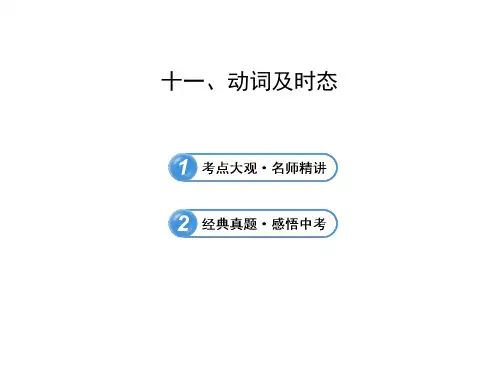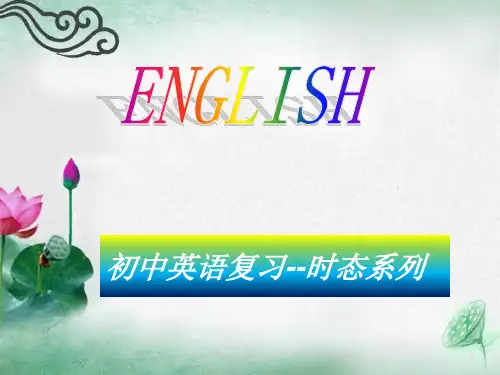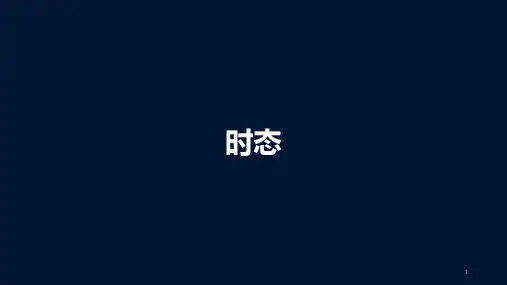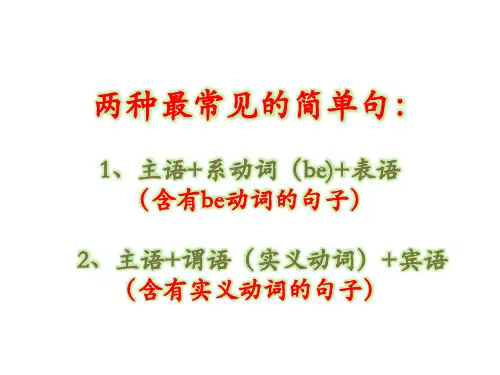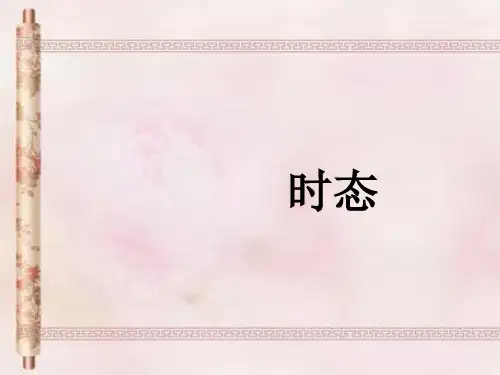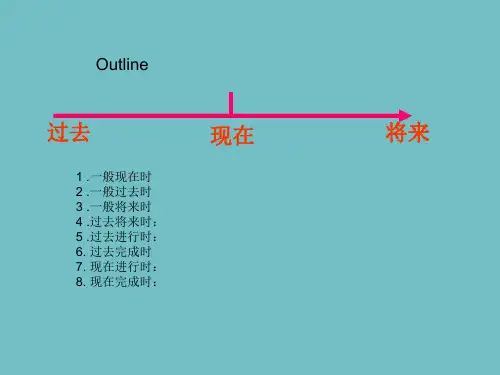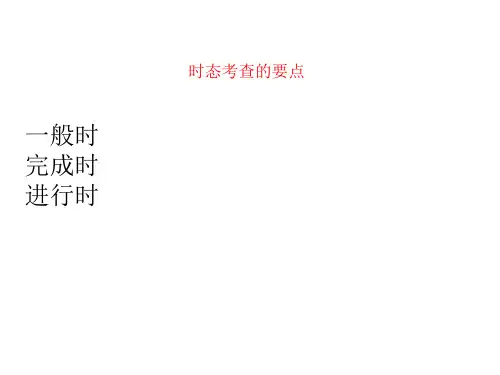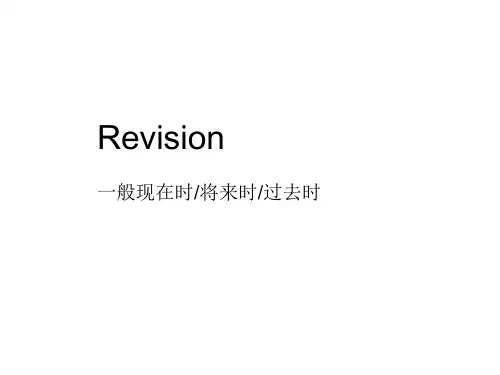- 1、下载文档前请自行甄别文档内容的完整性,平台不提供额外的编辑、内容补充、找答案等附加服务。
- 2、"仅部分预览"的文档,不可在线预览部分如存在完整性等问题,可反馈申请退款(可完整预览的文档不适用该条件!)。
- 3、如文档侵犯您的权益,请联系客服反馈,我们会尽快为您处理(人工客服工作时间:9:00-18:30)。
• 一般现在时表将来
• 1)下列动词come, go, arrive, leave, start, begin, return(瞬间动词)的一般现在时可以 表示将来,主要用来表示在时间上已确定或安排好的事情。
• 例如: The train leaves at six.火车六点的时候出发 • When does the bus start?——It starts in ten minutes.公交车什么时候出发?——十分钟后 • 2)以here, there等开始的倒装句,表示动作正在进行。 • 例如:Here comes the bus.=The bus is coming .车来了 • 3)在时间或条件句中。
叶子在变红。 It's getting warmer and warmer. 天越来越热了。
• 例如: I had hardly opened the door when he hit me. 我刚打开门,他就打了我。
• had no sooner…than 刚…… 就……。 • 例如: He had no sooner bought the car than he sold it.
他刚买了这辆车,转眼又卖了。
• a. 即将做某事,打算做某事。(主语的意图)
例如:What are you going to do tomorrow? 明天打算做什么呢?
• b. 计划,安排要发生的事。
例如:The play is going to be produced next month。这出戏下月开播。
• c. 有迹象要发生的事。
eg:It is time for you to go to bed. 你该睡觉了。
• It is time that sb. did sth. "时间已迟了" "早该……了"
eg:It is time you went to bed. 你早该睡觉了。
• (4) wish, wonder, think, hope 等用过去时,作试已不复存在。
• 在过去不同时间发生的两个动作中,发生在先,用过去完成时;发生在 后,用一般过去时。、
• 例如: When the police arrived, the thieves had run away. 警察到达时,小偷们早就跑了。
c. 表示意向的动词,如hope, wish, expect, think, intend, mean, suppose等,用过去完成时表示"原本…,未能…"。
• The students ___ busily when Miss Brown went to get a book she ___ in the office.
• A. had written, left
B.were writing, has left
• C. had written, had left D. were writing, had left
英语中的时态
1 一般现在时 2 一般过去时 3 一般将来时 4 现在完成时 5 过去完成时
6 将来完成时 7 现在进行时 8 过去进行时
一、一般现在时
• (1)经常性或习惯性的动作,常与表示频度的时间状语连用。 时间状语: every…, sometimes, at…, on Sunday。 eg: I leave home for school at 7 every morning. 每天早上我七点离开家。
• (2) 客观真理,客观存在,科学事实。
eg:The earth moves around the sun. 地球绕太阳转动。 Shanghai lies in the east of China. 上海位于中国东部。
• (3)表示格言或警句。
eg:Pride goes before a fall.
• be used to + doing: 对……已感到习惯,或"习惯于",to是介词,后需 加名词或动名词。
• eg:I am used to eating an apple in the morning.我习惯了早上吃一个苹果。
(3)句型:It is time for sb. to do sth "到……时间了" "该……了"。
例如:Look at the dark clouds, there is going to be a storm. 看那乌云,快要下雨了。
• (3)be about to +不定式,意为马上做某事。
例如: He is about to leave for Beijing. 他马上要去北京。
• 注意:be about to do 不能与tomorrow, next week 等表示明确 将来时的时间状语连用。
• 一般过去时常用的非持续性动词有come, go, leave, start, die, finish, become, get married等。
• 句子中如有过去时的时间副词(如yesterday, last, week, in 1960)时,不 能使用现在完成时,要用过去时。
五、过去完成时
• (2)表示在过去一段时间内,经常性或习惯性的动作。
used to / be used to : • used to + do:"过去常常"表示过去习惯性的动作或状态,但如今已不
存在。
eg:Mother used not to be so forgetful. 老妈过去没那么健忘。 Scarf used to take a walk. 斯卡夫过去常常散步。
• b. 习惯进行:表示长期的或重复性的动作,说话时动作未必正在进行。 • 例如: Mr. Green is writing another novel.
他在写另一部小说。(说话时并未在写,只处于写作的状态。)
• c. 表示渐变,这样的动词有:get, grow, become, turn, run, go, begin等。 • 例如: The leaves are turning red.
二、一般过去时
• (1)在确定的过去时间里所发生的动作或存在的状态。
• 时间状语有:yesterday, last week, an hour ago, the other day, in 1982等。 eg:I went to school yesterday. Last week we had an excited football game.
• 例如: You will have reached Shanghai by this time tomorrow. 明天此时,你已经到达上海了。
七、现在进行时
• 用法:
• a. 表示现在(指说话人说话时)正在发生的事情。 • 例如: We are waiting for you.
我们正在等你。
living by himself. 到了十二岁那年,爱迪生开始自己谋生。 Tom was disappointed that most of the guests had left
when he arrived at the party. 汤姆失望了,因为他到达晚会时,大部分客人已经走了。
• 典型例题
例如: We had hoped that you would come, but you didn't. 那时我们希望你能来,但是你没有来。
• 3) 过去完成时的时间状语before, by, until , when, after, once, as soon as
例如: He said that he had learned some English before. 他说过他以前学过一些英语。 By the time he was twelve, Edison had began to make a
例如: When Bill comes (不是will come), ask him to wait for me. 比尔来后,让他等我。
• 4)在动词hope, take care that, make sure that等的宾语从句中。 例如: I hope they have a nice time next week. 我希望他们下星期玩得开心。
• 答案D. "把书忘在办公室"发生在"去取书"这一过去的动作之前, 因此"忘了书"这一动作发生在过去的过去,用过去完成时。句 中when表示的是时间的一点,表示在"同学们正忙于……"这一 背景下,when所引导的动作发生。因此前一句应用过去进行 时。
• 注意: had hardly… when 还没等…… 就……。
• 表示过去的过去
• 其构成:had +过去分词构成。
• 用法: • a. 在told, said, knew, heard, thought等动词后的宾语从句。 例如: She said (that)she had never been to Paris.
她告诉我她曾去过巴黎。
• b. 状语从句
骄者必败。
• (4)现在时刻的状态、能力、性格、个性。
比较这两个句子: • Now I put the sugar in the cup.
把糖放入杯子。 • I am doing my homework now.
我正在做功课。
第一句用一般现在时,用于操作演示或指导说明的示范性动作,表示言行的瞬 间动作。第二句中的now是进行时的标志,表示正在进行的动作的客观状况,所 以后句用一般进行时。
• 其构成:have (has) +过去分词。
eg: I have finished my homework. 我已经完成了我的作业
